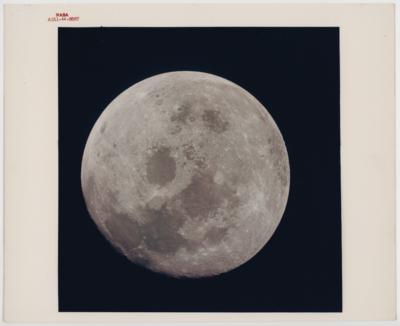Michael Collins (Apollo 11)
The first full Moon photographed by humans from a perspective different from Earth, 16-24 July 1969
Vintage chromogenic print on fiber-based paper, printed 1969, numbered "NASA AS 11-44-6667" (NASA MSC) in red in top margin, with "A KODAK PAPER" watermark on verso, 20,3 x 25,4 cm
A full Moon, but not a Moon familiar to humans. This is a new Moon in the sense that it was one that had been walked upon by humans. This is a Moon that Michael Collins photographed as Apollo 11 departed the Earth. The Earthward face is to the bottom, the far side is to the top, and the geometry of the situation meant that on Earth, located off camera to the bottom, anyone looking would see a half Moon. The large, isolated dark marking near the center is the Sea of Crisis with which humans are familiar as appearing near the Moon’s limb. (Mailer, p.493)
“It really does appear that there are three different Moons. One that you’re on, one that you’re in orbit of, and one that’s a long way away. And they don’t blend, and you don’t get the transition. There was only one exception to it, and that was shortly after we left the Moon, heading back to Earth, after we made the burn and it was okay. Then we could orient and look back and watch it grow smaller, from the back side... And that was the only time when we were really allowed to experience the change.”
Buzz Aldrin (Chaikin, Voices, p. 119).
Specialist: Mag. Eva Königseder
 Mag. Eva Königseder
Mag. Eva Königseder
+43-1-515 60-421
eva.koenigseder@dorotheum.at
27.09.2023 - 16:20
- Realized price: **
-
EUR 2,080.-
- Estimate:
-
EUR 1,200.- to EUR 1,800.-
- Starting bid:
-
EUR 600.-
Michael Collins (Apollo 11)
The first full Moon photographed by humans from a perspective different from Earth, 16-24 July 1969
Vintage chromogenic print on fiber-based paper, printed 1969, numbered "NASA AS 11-44-6667" (NASA MSC) in red in top margin, with "A KODAK PAPER" watermark on verso, 20,3 x 25,4 cm
A full Moon, but not a Moon familiar to humans. This is a new Moon in the sense that it was one that had been walked upon by humans. This is a Moon that Michael Collins photographed as Apollo 11 departed the Earth. The Earthward face is to the bottom, the far side is to the top, and the geometry of the situation meant that on Earth, located off camera to the bottom, anyone looking would see a half Moon. The large, isolated dark marking near the center is the Sea of Crisis with which humans are familiar as appearing near the Moon’s limb. (Mailer, p.493)
“It really does appear that there are three different Moons. One that you’re on, one that you’re in orbit of, and one that’s a long way away. And they don’t blend, and you don’t get the transition. There was only one exception to it, and that was shortly after we left the Moon, heading back to Earth, after we made the burn and it was okay. Then we could orient and look back and watch it grow smaller, from the back side... And that was the only time when we were really allowed to experience the change.”
Buzz Aldrin (Chaikin, Voices, p. 119).
Specialist: Mag. Eva Königseder
 Mag. Eva Königseder
Mag. Eva Königseder
+43-1-515 60-421
eva.koenigseder@dorotheum.at
|
Buyers hotline
Mon.-Fri.: 10.00am - 5.00pm
kundendienst@dorotheum.at +43 1 515 60 200 |
| Auction: | The Beauty of Space - Iconic Photographs of Early NASA Missions |
| Auction type: | Online auction |
| Date: | 27.09.2023 - 16:20 |
| Location: | Wien | Palais Dorotheum |
| Exhibition: | Online |
** Purchase price incl. buyer's premium and VAT
It is not possible to turn in online buying orders anymore. The auction is in preparation or has been executed already.

